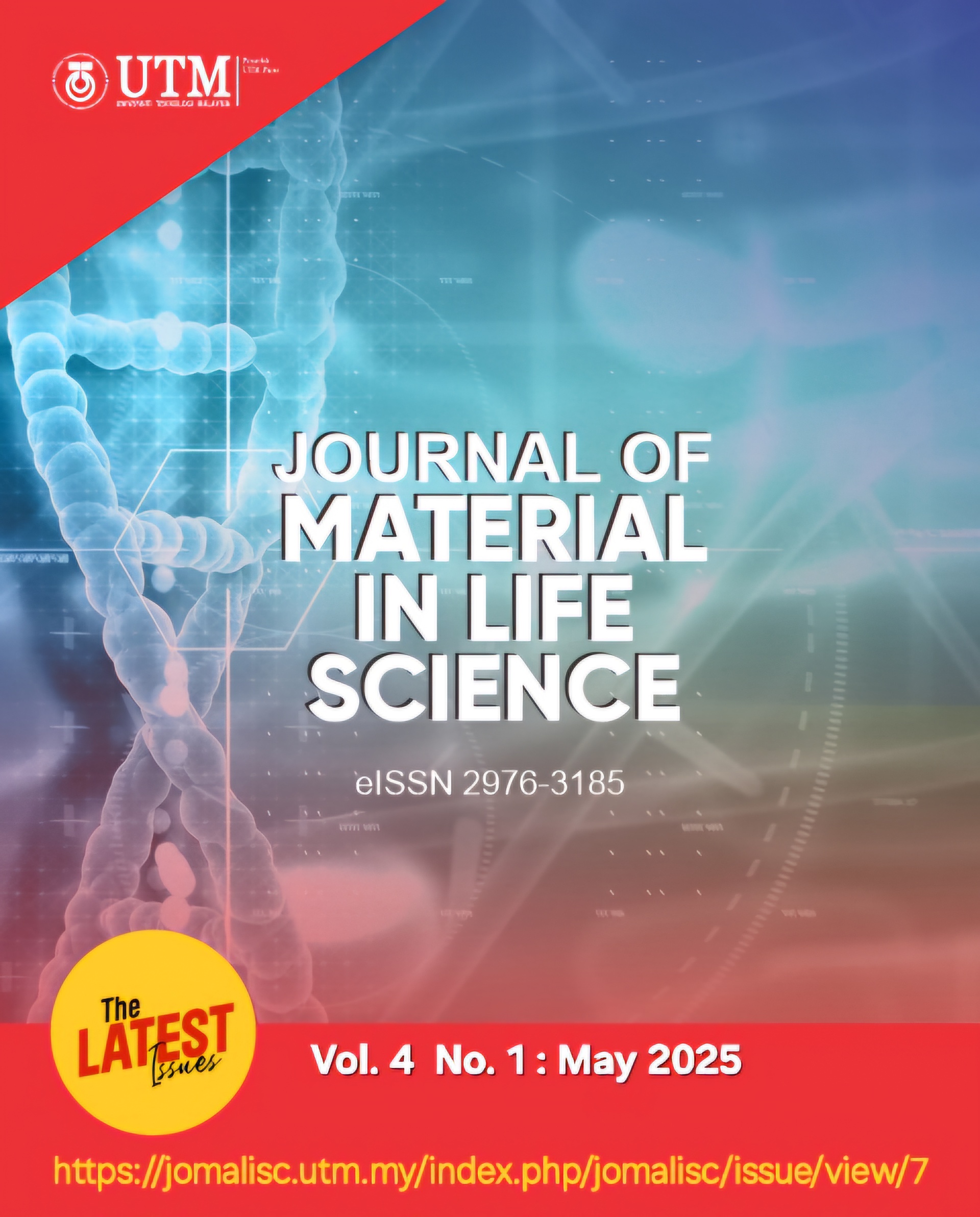Deep Eutectic Solvent Derived from Paracetamol for Efficient Enzymatic Biotransformation
DOI:
https://doi.org/10.11113/jomalisc.v4.83Keywords:
Deep Eutectic Solvent, Biotransformation, Lipase Candida Rugosa, Ionic LiquidsAbstract
Deep Eutectic Solvent (DES) has emerged as a promising green solvent for use in various chemical reactions, including enzymatic reactions. In this study, a paracetamol-based DES was synthesized and characterized for its physicochemical properties. Additionally, molecular simulation was performed to investigate the DES's effect on the Candida rugosa lipase activity. The characterization analyses confirmed that the paracetamol-based DES possessed similar functional groups to its original components but exhibited a lower melting point. The enzymatic activity of the lipase in the presence of the synthesized DES was significantly enhanced, leading to a high yield of free fatty acids (348.30 µmole). This study is the first to demonstrate the use of a paracetamol-based DES for enzymatic activity, providing evidence that DESs are an efficient replacement for conventional organic solvents in enzyme-catalyzed reactions. Molecular simulation results showed that the DES's active ingredient, pTSA, exhibited potent catalytic properties and protonation abilities, which contributed to the observed enhancement in lipase activity. Furthermore, the paracetamol molecule present in the DES was found to have a significant impact on the chemical environment surrounding lipase, leading to indirect effects on its activity. In conclusion, this study offers a promising strategy for utilizing greener solvents in enzymatic reactions, demonstrating the potential of DESs as a versatile tool for enhancing the catalytic activity of enzymes. The results of this study highlight the importance of exploring alternative green solvents and provide a foundation for future research in this area.
References
Fatima S, Asif N, Ahmad R, Fatma T. Toxicity of NSAID drug (paracetamol) to nontarget organism-Nostoc muscorum. Environ Sci Pollut Res Int. 2020;27(28):35208-16.
Spaltro A, Pila MN, Colasurdo DD, Noseda Grau E, Roman G, Simonetti S, et al. Removal of paracetamol from aqueous solution by activated carbon and silica. Experimental and computational study. J Contam Hydrol. 2021;236:103739.
Courtier A, Cadiere A, Roig B. Human pharmaceuticals: Why and how to reduce their presence in the environment. Current Opinion in Green and Sustainable Chemistry. 2019;15:77-82.
Pollap A, Baran K, Kuszewska N, Kochana J. Electrochemical sensing of ciprofloxacin and paracetamol in environmental water using titanium sol based sensor. Journal of Electroanalytical Chemistry. 2020;878.
Mane SN, Gadalkar SM, Rathod VK. Intensification of paracetamol (acetaminophen) synthesis from hydroquinone using ultrasound. Ultrason Sonochem. 2018;49:106-10.
Zur J, Wojcieszynska D, Hupert-Kocurek K, Marchlewicz A, Guzik U. Paracetamol - toxicity and microbial utilization. Pseudomonas moorei KB4 as a case study for exploring degradation pathway. Chemosphere. 2018;206:192-202.
Gotor-Fernandez V, Paul CE. Deep eutectic solvents for redox biocatalysis. J Biotechnol. 2019;293:24-35.
Mao S, Wang X, Zhang Z, Wang S, Li K, Lu F, et al. 15α-hydroxylation of D-ethylgonendione by Penicillium raistrickii in deep eutectic solvents DESs containing system. Biochemical Engineering Journal. 2020;164.
Patzold M, Siebenhaller S, Kara S, Liese A, Syldatk C, Holtmann D. Deep Eutectic Solvents as Efficient Solvents in Biocatalysis. Trends Biotechnol. 2019;37(9):943-59.
Sun H, Xin R, Qu D, Yao F. Mechanism of deep eutectic solvents enhancing catalytic function of cytochrome P450 enzymes in biosynthesis and organic synthesis. J Biotechnol. 2020;323:264-73.
Halilu A, Hadj-Kali MK, Hashim MA, Yusoff R, Aroua MK. Bifunctional Ionic Deep Eutectic Electrolytes for CO2 Electroreduction. ACS Omega. 2022;7(42):37764-73.
Halilu A, Hadj-Kali MK, Hashim MA, Ali EM, Bhargava SK. Electroreduction of CO2 and Quantification in New Transition-Metal-Based Deep Eutectic Solvents Using Single-Atom Ag Electrocatalyst. ACS Omega. 2022;7(16):14102-12.
Tan JN, Dou Y. Deep eutectic solvents for biocatalytic transformations: focused lipase-catalyzed organic reactions. Appl Microbiol Biotechnol. 2020;104(4):1481-96.
Frisch M, Trucks G, Schlegel H, Scuseria G, Robb M, Cheeseman J, et al. Gaussian 09 Rev. D. 01, Wallingford, CT. 2009.
Peppernick SJ. United atoms to superatoms and the isoelectronic principle: The Pennsylvania State University; 2009.
Dennington R, Keith T, Millam J. GaussView, version 5. 2009.
Halilu A, Hayyan M, Aroua MK, Yusoff R, Hizaddin HF. In Situ Electrosynthesis of Peroxydicarbonate Anion in Ionic Liquid Media Using Carbon Dioxide/Superoxide System. ACS applied materials & interfaces. 2019;11(29):25928-39.
Halilu A, Hayyan M, Aroua MK, Yusoff R, Hizaddin HF. Mechanistic insights into carbon dioxide utilization by superoxide ion generated electrochemically in ionic liquid electrolyte. Physical Chemistry Chemical Physics. 2021;23(2):1114-26.
Rodriguez Rodriguez N, Machiels L, Binnemans K. p-Toluenesulfonic Acid-Based Deep-Eutectic Solvents for Solubilizing Metal Oxides. ACS Sustainable Chemistry & Engineering. 2019;7(4):3940-8.
Kamarudin AF, Hizaddin HF, El-Blidi L, Ali E, Hashim MA, Hadj-Kali MK. Performance of p-Toluenesulfonic Acid-Based Deep Eutectic Solvent in Denitrogenation: Computational Screening and Experimental Validation. Molecules. 2020;25(21).
Duranovic M, Obeid S, Madzarevic M, Cvijic S, Ibric S. Paracetamol extended release FDM 3D printlets: Evaluation of formulation variables on printability and drug release. Int J Pharm. 2021;592:120053.
Feng C, Zhu J, Hou Y, Qin C, Chen W, Nong Y, et al. Effect of temperature on simultaneous separation and extraction of hemicellulose using p-toluenesulfonic acid treatment at atmospheric pressure. Bioresour Technol. 2022;348:126793.
Dodson GG, Lawson DM, Winkler FK. Structural and evolutionary relationships in lipase mechanism and activation. Faraday Discussions. 1992;93(0):95-105.


















